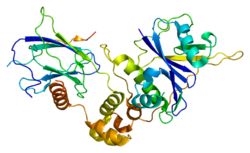Von Hippel Lindau tumor suppressor
| Von Hippel Lindau tumor suppressor | ||
|---|---|---|

|
||
| other names |
|
|
|
Existing structure data: 1LM8 , 1LQB , 1VCB , 3ZRC , 3ZRF , 3ZTC , 3ZTD , 3ton , 4AJY , 4AWJ , 4B95 , 4B9K , 4BKS , 4BKT , 4W9C , 4W9D , 4W9E , 4W9F , 4W9G , 4W9H , 4W9I , 4W9J , 4W9K , 4W9L , 4WQO |
||
| Properties of human protein | ||
| Mass / length primary structure | 24,153 Daltons / 213 amino acids (Isoform1)
19,654 daltons / 172 amino acids (isoform2) 18,532 daltons / 160 amino acids (isoform3) |
|
| Isoforms | 3 | |
| Identifier | ||
| Gene name | VHL | |
| External IDs | ||
| Orthologue | ||
| human | House mouse | |
| Entrez | 7428 | 22346 |
| Ensemble | ENSG00000134086 | ENSMUSG00000033933 |
| UniProt | P40337 | P40338 |
| Refseq (mRNA) | NM_000551 | NM_009507 |
| Refseq (protein) | NP_000542 | NP_033533 |
| Gene locus | Chr 3: 10.14 - 10.15 Mb | Chr 6: 113.62 - 113.63 Mb |
| PubMed search | 7428 |
22346
|
The Von Hippel Lindau tumor suppressor (pVHL) is a tumor suppressor encoded by the VHL gene . Mutations in this gene are the cause of von Hippel-Lindau's disease .
physiology
There are four different isoforms of the VHL protein: pVHL-213, pVHL-160, pVHL-172 and pVHL-X1. The protein is part of a protein complex that consists of elongin B , elongin C and cullin-2 and has ubiquitin ligase E3 activity. The ubiquitination of proteins in the proteasome is a "marking" that leads to the subsequent degradation of the protein. The pVHL complex binds to hypoxia-induced factors (HIFs), which are then ubiquitinated. This HIFs need for a binding of pVHL previously at two prolines hydroxylated be, and this process is dependent on the oxygen concentration. Accordingly, pVHL plays an important role in the cellular perception of oxygen deficiency ( hypoxia ), the cellular signaling pathway and oxygen-dependent gene expression . Vascular Endothelial Growth Factors (VEGFs), which are also important for the formation of blood vessels ( angiogenesis ) in tumors, are among the proteins that are increasingly expressed when there is a lack of oxygen .
The researchers William G. Kaelin , Peter J. Ratcliffe and Gregg L. Semenza received the Nobel Prize in Physiology or Medicine in 2019 for the discovery of cellular signaling pathways in the presence of oxygen deficiency and also of pVHL .
VHL mutations
Mutations in the VHL gene with a partial loss of function can result in various genetic diseases with different characteristics and different clinical symptoms, including:
- VHL syndrome ( von Hippel-Lindau's disease ) with multiple cyst formations and a number of rare tumors such as hemangioblastomas , pheochromocytomas and renal cell carcinomas , caused by an inherited mutation with inactivation of an allele and another somatic mutation ("second hit")
- Familial erythrocytosis type 2 with autosomal recessive polycythemia . This is caused by a homozygous mutation of the VHL gene, a point mutation (C598T) with an amino acid exchange (R200W), which is referred to as the "canonical" mutation of the VHL and especially on Ischia in Italy and among the Chuvashes in the autonomous Russian region of Chuvashia occurs frequently (hence also "Chuvash polycythemia"). There is no increased tumor rate here. Due to the reduced function
of pVHL, fewer HIFs are ubiquitinated and broken down, which is why an increased reaction to a lack of oxygen or even hypoxia-like symptoms can arise without a lack of oxygen, and this can result in erythrocythemia or polycythemia, similar to high-altitude training .
Individual evidence
- ↑ UniProt P40337
- ↑ von Hippel-Lindau tumor suppressor, E3 ubiquitin protein ligase
- ↑ a b Silverio Perrotta, Domenico Roberti, Debora Bencivenga, Paola Corsetto, Katie A. O'Brien, Martina Caiazza, Emanuela Stampone, Leanne Allison, Roland A. Fleck, Saverio Scianguetta, Immacolata Tartaglione, Peter A. Robbins, Maddalena Casale, James A. West, Clara Franzini-Armstrong, Julian L. Griffin, Angela M. Rizzo, Antonio A. Sinisi, Andrew J. Murray, Adriana Borriello, Federico Formenti, Fulvio Della Ragione: Effects of Germline VHL Deficiency on Growth, Metabolism, and mitochondria . New England Journal of Medicine 2020, Volume 382, Issue 9, February 27, 2020, Pages 835-844, DOI: 10.1056 / NEJMoa1907362
- ↑ The Nobel Prize in Physiology or Medicine 2019. Retrieved October 11, 2019 (American English).